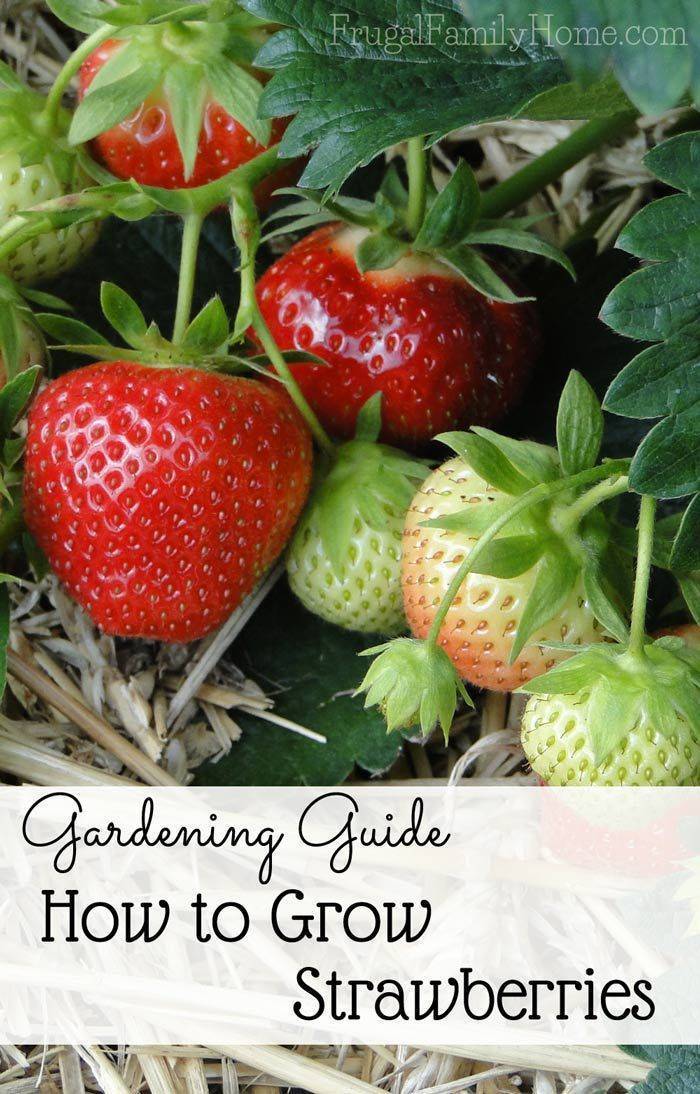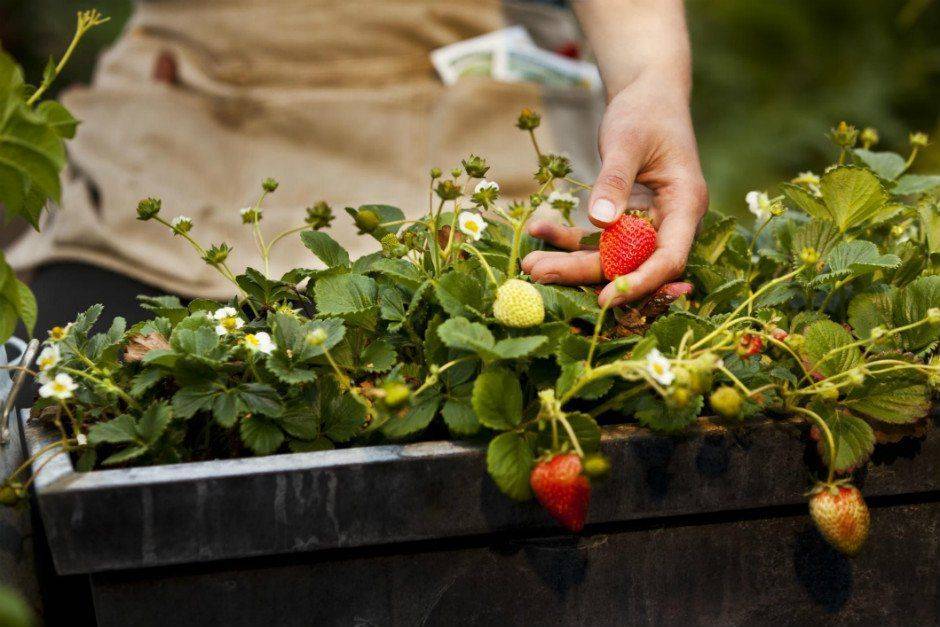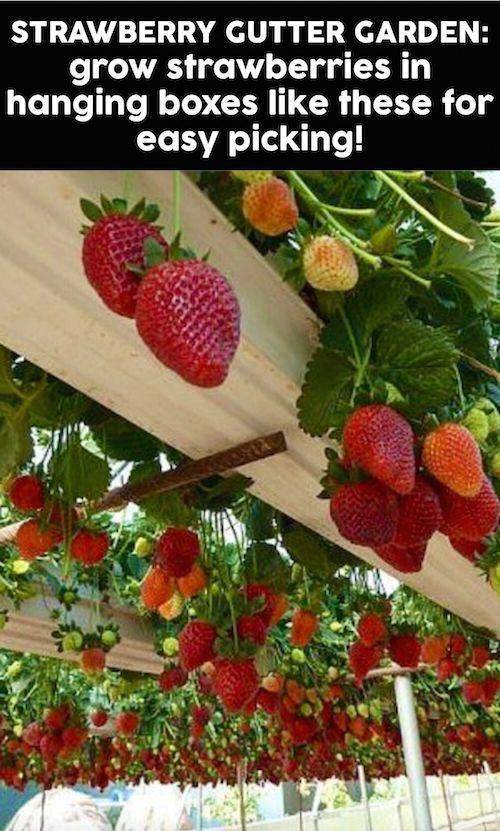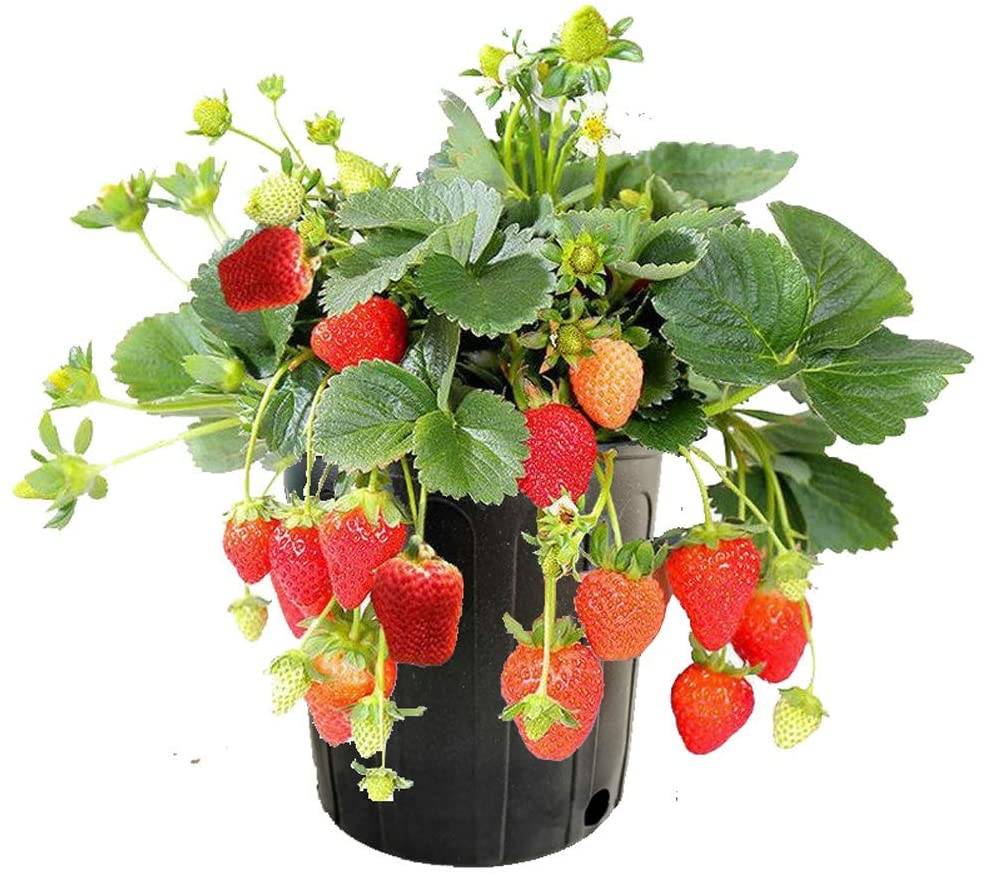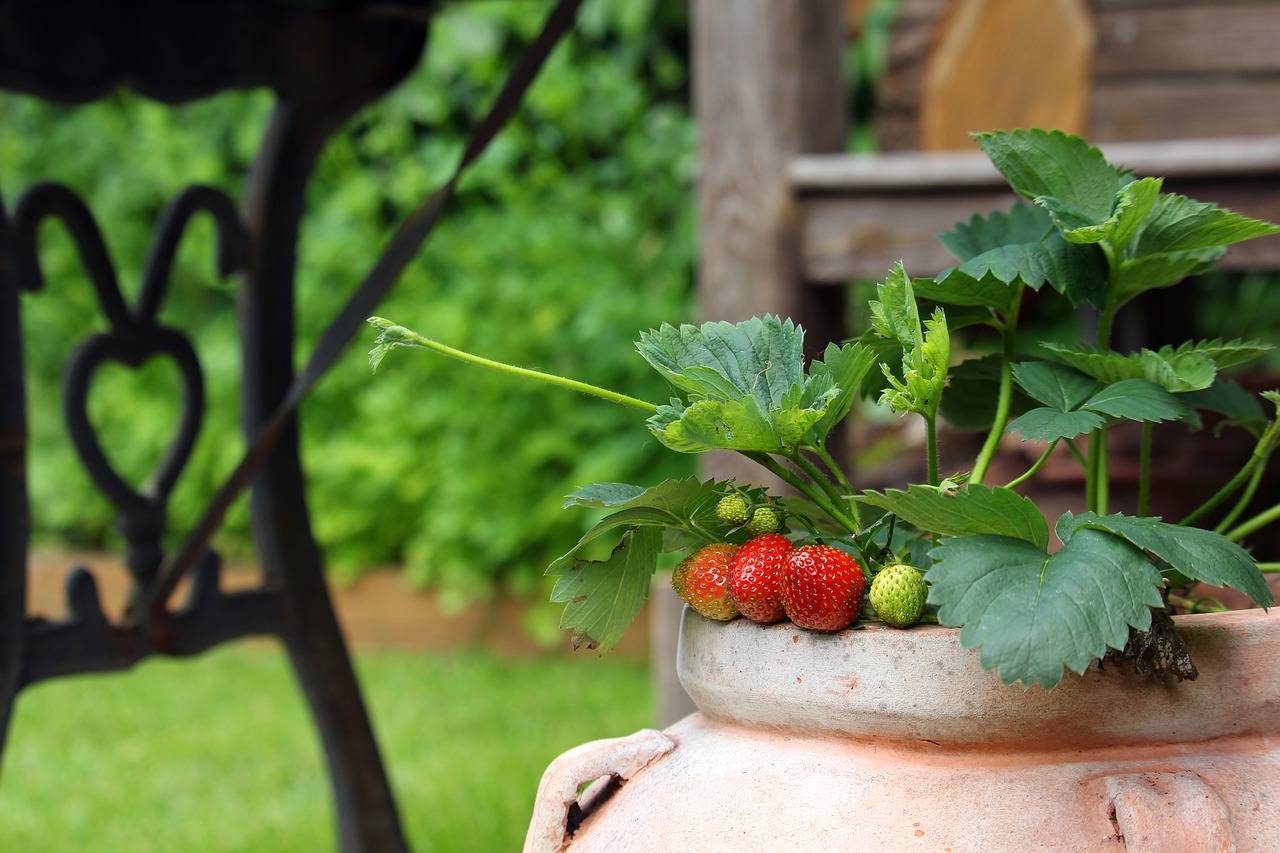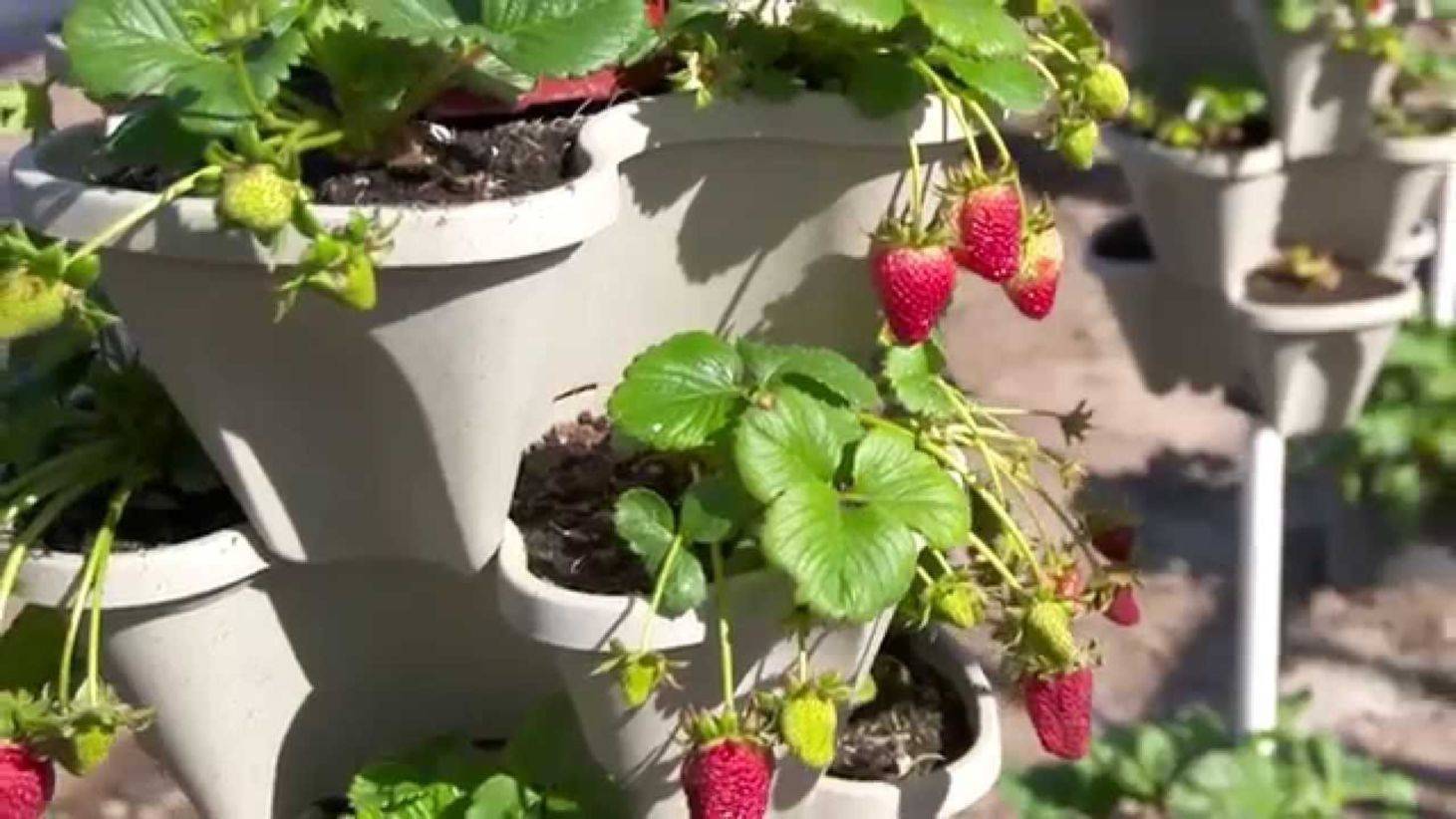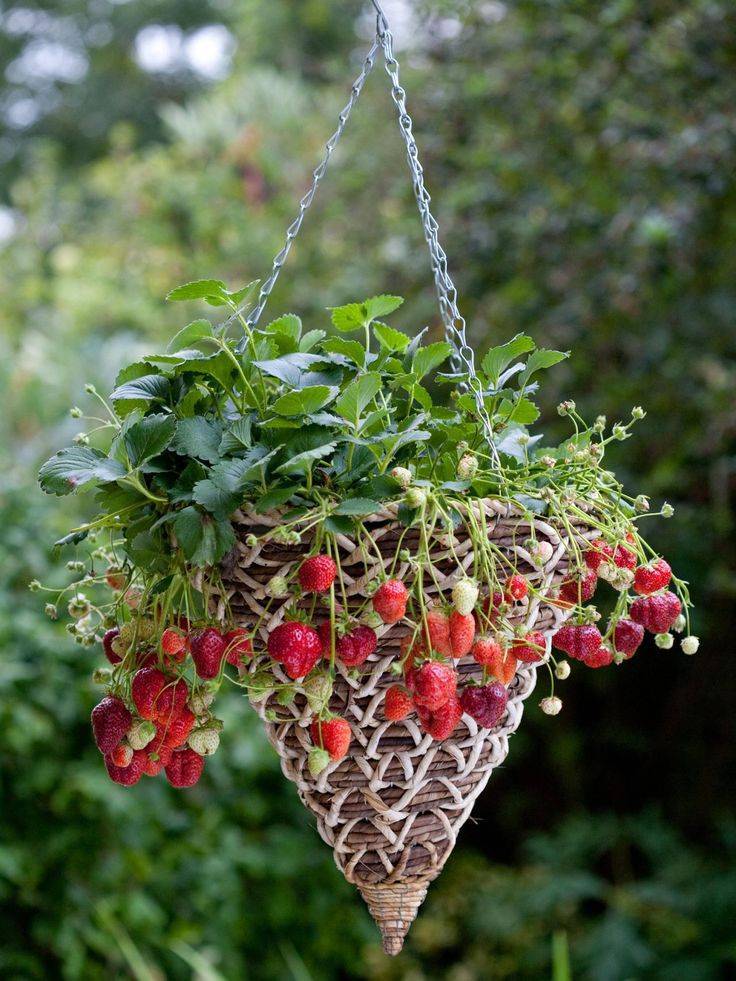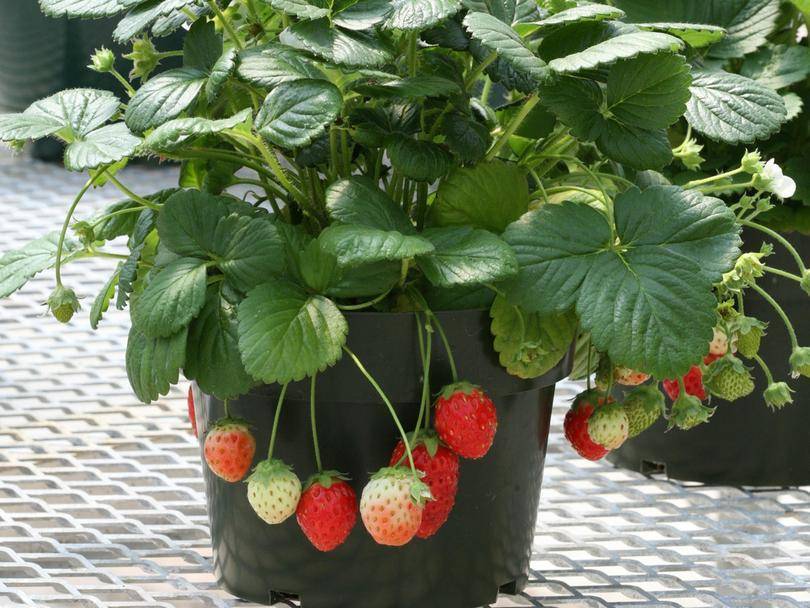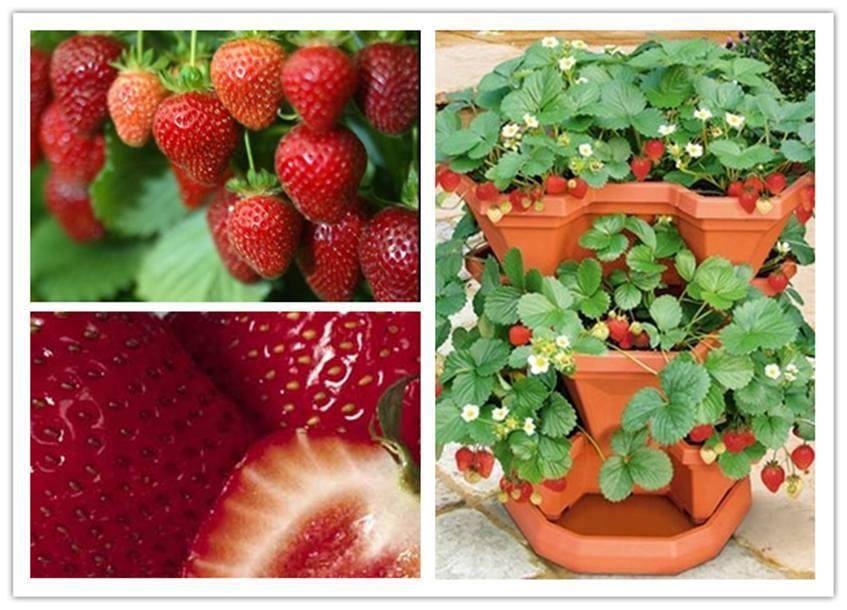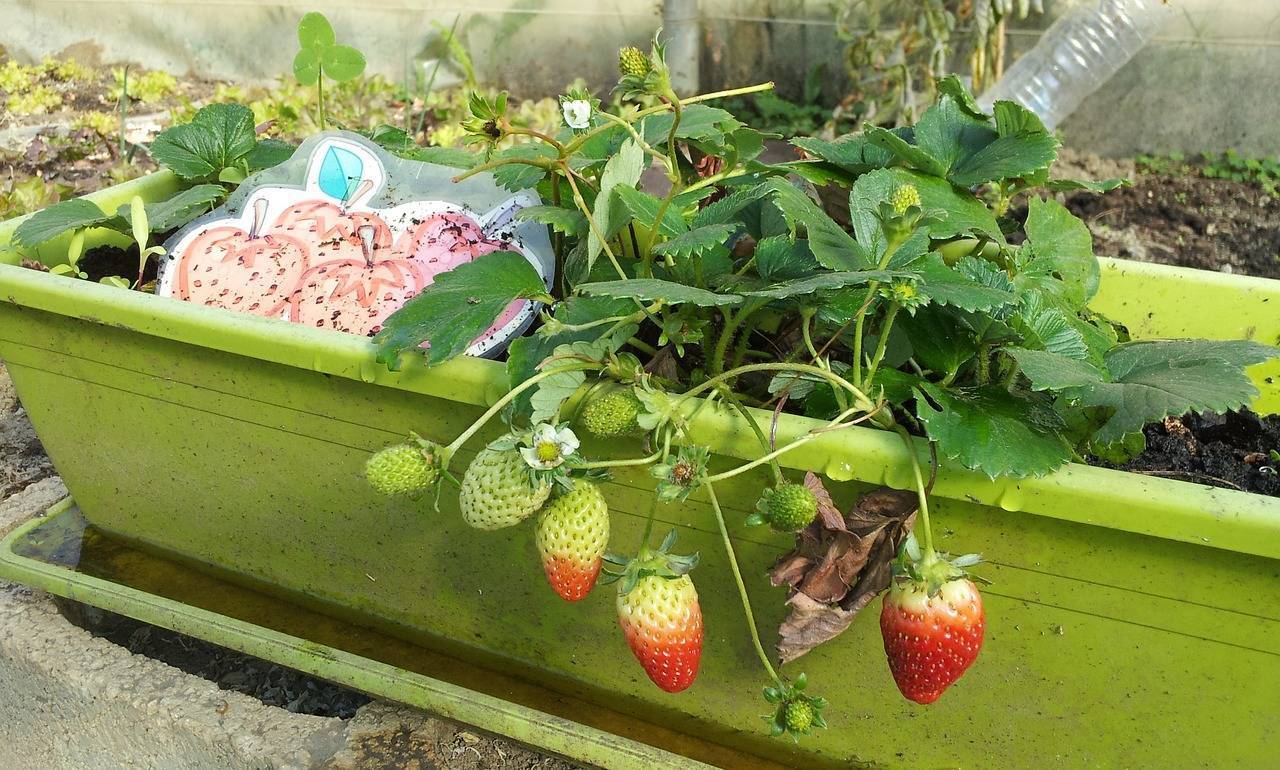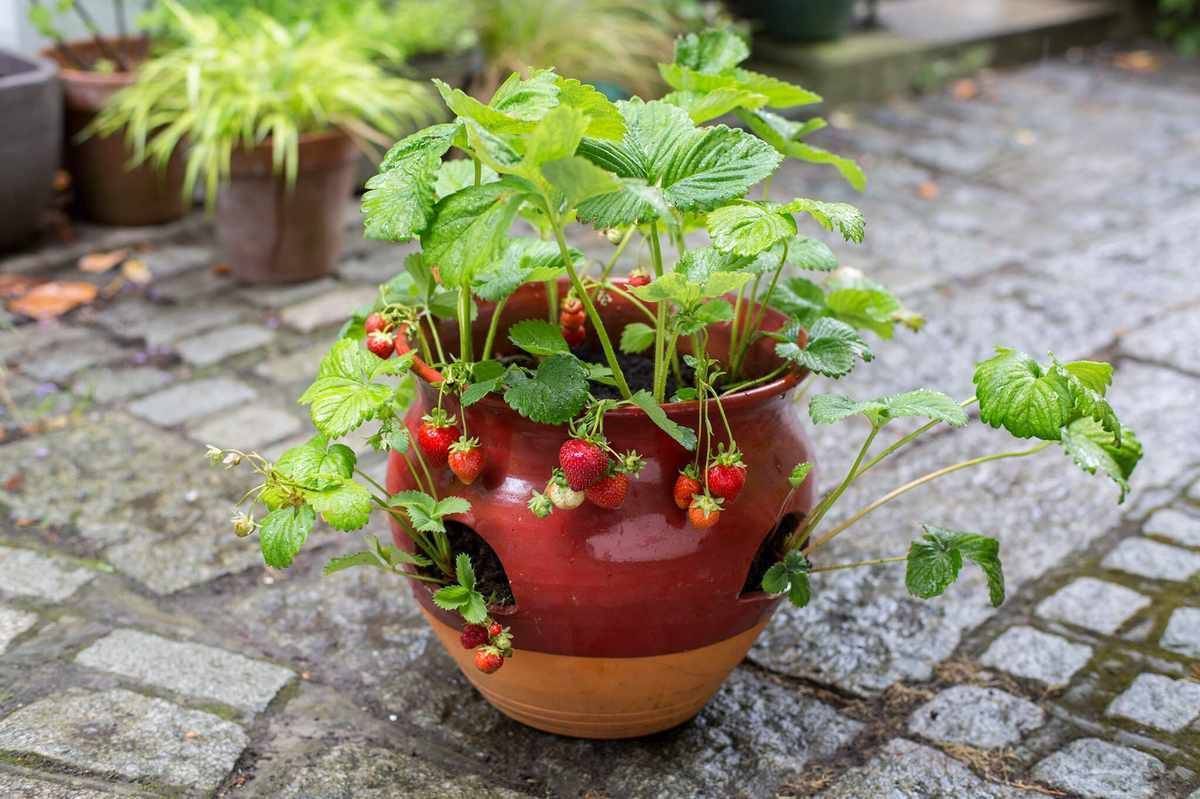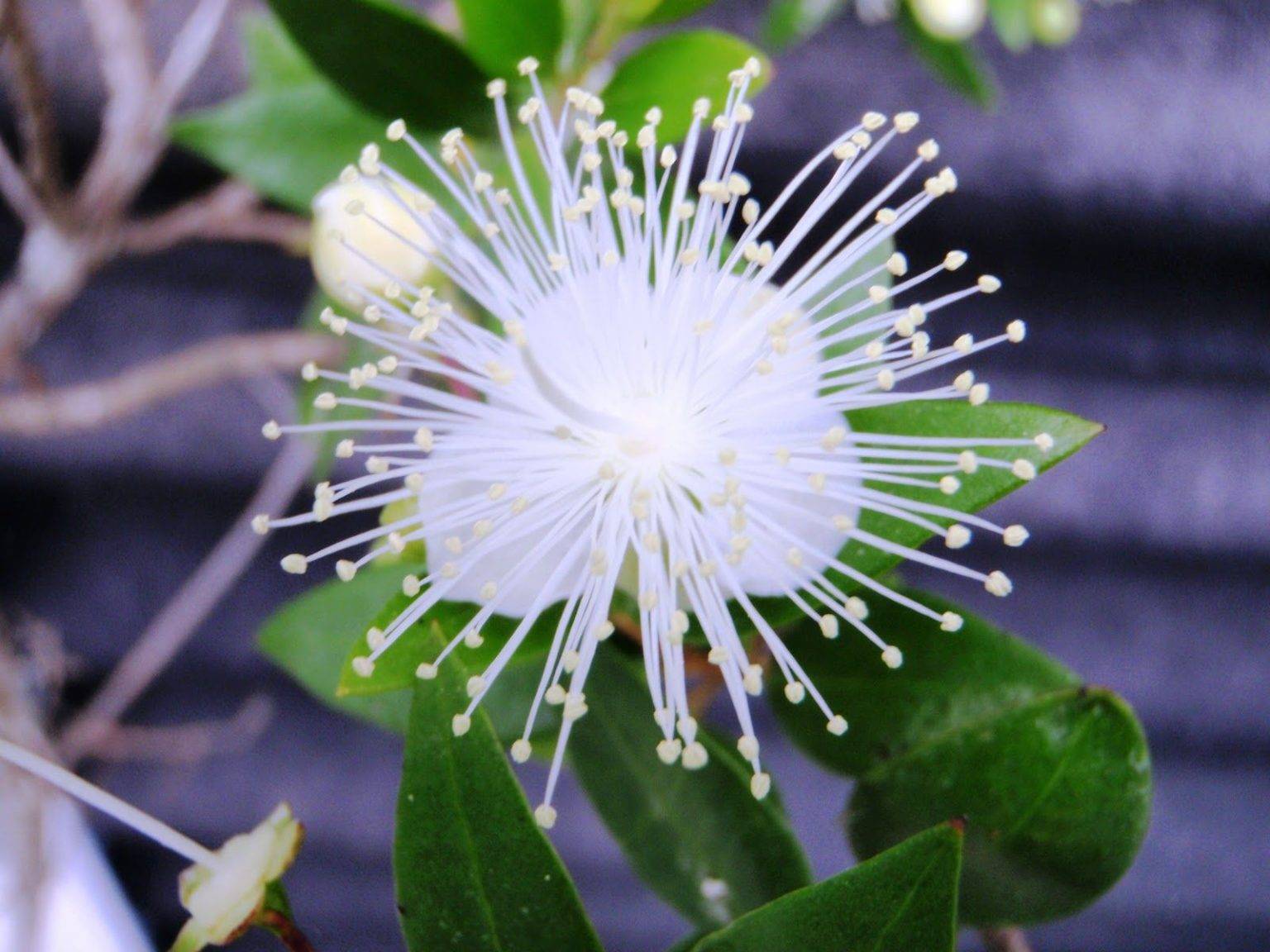Growing Strawberries Care Tips
Once planted, growing this fruiting crop is pleasingly easy.
Be sure to weed regularly around the crown of the plants. This helps to prevent new growth from becoming smothered.
As the fruit begins to develop, place straw underneath the fruit. Fibre mats, such as these Coconut Flower Pot Liners can also be cut up and used. This helps to suppress weeds as well as keeping the fruit dry and clean. Wet fruit, or fruit allowed to contact damp soil for a prolonged period can rot.
How to Water
Water regularly, especially when the plants are in fruit. In general, if it doesn’t rain, each plant requires between 1 and 2 inches of water a week. This varies depending on the growing conditions. If you are unsure, water only when the soil is dry.
The Yoyomax Soil Test kit allows you to accurately monitor the moisture content of your soil. It also allows you to monitor how much light the plants are receiving as well as the health and pH levels of the soil.
When watering try to keep the foliage and the crown of the plant as dry as possible.
If you struggle to carry a heavy watering can around the garden, try investing in an expandable hose. These are easy to use and tidy away.
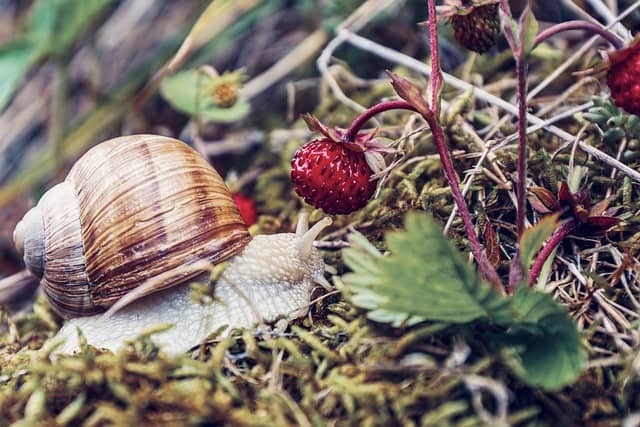 Applying a natural mulch, such as straw, helps to protect fruit from slugs and snails. As organic mulches slowly break down they also help to enrich the soil.
Applying a natural mulch, such as straw, helps to protect fruit from slugs and snails. As organic mulches slowly break down they also help to enrich the soil.
Fertilizing Strawberries
When planting apply a balanced organic fertilizer. A dose of one pound per 100 square feet is sufficient. Repeat this application after the plants have finished bearing fruit for the year.
In colder climates try not to fertilize in the late season. Fertilizing as the temperatures are about to fall may cause new foliage to emerge and become damaged by winter frosts.
If you want an alternative to chemical products, try making your own plant fertilizer. This is a pleasingly rewarding process that allows you to know exactly what you are putting in your soil.
Be careful not to over fertilize your plants. This can cause excessive foliage production often at the expense of flower and fruit production.
How to Propagate Strawberry Plants
Growing strawberries spread by setting out stem runners. These then root in the soil, forming new plants. To propagate strawberries, allow the runners to root.
Once the roots have formed, cut the stems connecting the plants. You can now carefully dig up the plantlets and plant in a new location.
This form of propagation is best done in early fall.
If you want to speed up the process, pin down the runners, forcing them to contact the soil. Pinning the runners down in this manner encourages the plant to form new roots.
Providing Winter Protection
In frost prone areas prune and tidy up the plants once fruiting has finished. Cover with a straw mulch or horticultural fleece such as the Agribon AG-19 Frost Blanket.
Plants in containers can simply be moved inside or to a more sheltered position.
Should frost damage the plant, prune away affected areas.
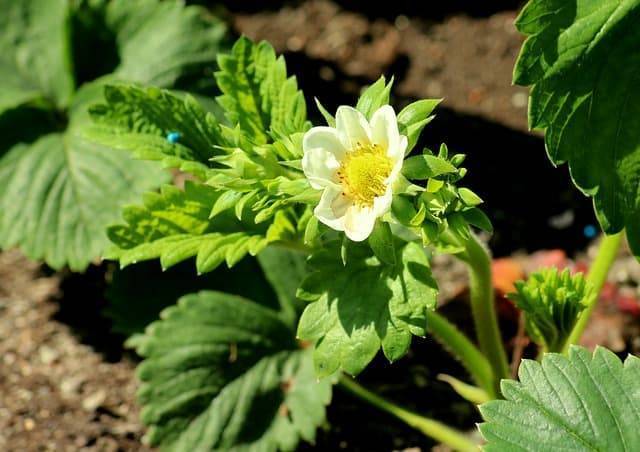 Properly protecting plants during the fall and winter months helps growing strawberries to return stronger the following year.
Properly protecting plants during the fall and winter months helps growing strawberries to return stronger the following year.
Companion planting
Strawberries are largely easy going plants. This makes them a good companion plant. Avoid planting in the same soil that has recently grown eggplants, peppers and tomatoes. These plants are all susceptible to verticillium wilt which can also affect growing strawberries.
Strawberries also seem to benefit from growing close to borage, bush beans, caraway and lupins.
Avoid growing strawberry plants near brassicas such as cauliflowers. Members of the brassica family often have their growth stunted if planted too closely to strawberries.
Strawberry Propagation by Planting Strawberry Seeds
Visit the Strawberry Seeds page for the details on how to plant and start strawberry seeds and the Growing Strawberries page for help propagating strawberry plants by nurturing the seedlings into viable, mature strawberry plants.
Growing strawberries from seeds has the potential for vast numbers of new strawberry plants to be grown. Each strawberry has approximately 200 seeds adorning its outer surface. While unusual for every seed to be viable, that is still a lot of new plants from a single strawberry. Starting strawberry seeds will require most of the standard seed-starting equipment to be used. And, while starting strawberry seeds often requires a few more considerations than does starting common garden vegetables from seeds, it is not overly difficult.
The major drawback of strawberry propagation by seed is the nature of today’s common strawberry cultivars (visit the Strawberry Plant page for the history). Once the Garden Strawberry (Fragaria x ananassa) became the dominant strawberry grown in both home gardens and commercial operations, the seeds became unreliable due to the crossbreeding used to obtain the improved strawberry varieties. This means that attempting to grow strawberry plants from seeds that were collected from a purchased strawberry will likely not produce true plants. In other words, the plants grown from seed will be different from the plant that produced the seeds (sometimes substantially so). The seed-propagated strawberry plants will exhibit genetic traits of the grandparent plants instead of the desired parent plant. The wild strawberry species are an exception to this and will produce plants true-to-form. However, their fruits are much smaller, in general, and not recognized by most as the “strawberries” that are commonly bought and consumed today.
Common Pests and Diseases
If correctly planted, growing strawberries is a largely trouble free process. Young or growing plants require protection from slugs and snails.
Birds can also devastate crops, quickly removing all your fresh fruit. Covering the plants with netting is the easiest way to protect your harvest.
Grey mould or botrytis is common if growing in damp or humid conditions. As the name suggests this disease causes grey, fungal growth to form on foliage. It can also damage the fruit. Cut away and destroy affected areas. Spacing correctly and keeping the foliage as dry as possible helps to prevent this.
Plants growing in humid areas may suffer from powdery mildew. This causes foliage to shrivel. It may also cause white powder to appear on the plants. Correctly spacing the plants, so that air is able to freely circulate, and keeping the foliage as dry as possible helps to prevent mildew. Reducing the temperature around the plants and keeping the soil moist also helps to keep the plants healthy.
If vine weevils strike apply a chemical or organic control.
Aphids and other bugs can also be washed away or removed with an application of insecticidal soap. Neem oil can also be wiped over the leaves to remove aphids.
What need to start Hydroponic Strawberries
ebb and flow, deep water culture (DWC) and nutrient film technique (NFT) are four popular types of hydroponic systems that are often used to grow berries in.
The first step is to find a good hydroponic system. They vary in price, how many plants they can grow and their performance. Spend some time looking at different systems before you buy one.
When you first start growing, it is best to use an ebb and flow system or a hydroponic drip system. There are also some good ones that are ready to grow.
You can do this at home with a garden tray, a water pump, and other things. You can get started without spending too much money.
Building a system for growing plants is easy. To do this, set up the water reservoir under the tray with your plants. Then, put in a pump and timer so that water flows from the reservoir to keep your plants watered and fed.
You will need to choose a growing medium. You can use growstones, clay pebbles, coconut coir, or rockwool. There are many different types of growing media that you can choose from!
Pollination
If you want to cross-breed strawberries, you need to pollinate them. If bees don’t have access to your plants, it may be necessary for you to pollinate them yourself. Hydroponic systems are an indoor growing style, so a supply of bees is important if you want your strawberries to produce fruit.
You can pollinate strawberries by hand. You don’t need to find male or female flowers, so use a cotton swab to collect pollen from one flower and transfer it to another, then repeat across all your plants. This will become tedious if you have many plants to pollinate, but it is simple and very effective.
If you are growing your plants outside, and you have pollinating insects around, you won’t need to do this. But anyone who grows their plants inside will want to hand-pollinate for better fruit development.
Pruning
To keep your strawberries healthy and growing well, cut off the runners. Runners are leafless stems that grow out of the plant. If you don’t want more plants, cut them off as close to the base of the plant as possible. You can use a runner with a new plant growing at its tip for propagation!
Propagation
Strawberry plants start with seeds or plantlets.
Get seed from a reliable source. For example, you can get it by collecting berries from the plants in your yard. But if the plant is a hybrid, it may not grow true. So buy seed and plant it in potting soil indoors and wait for it to germinate and become a small plant. Then keep the seed moist and warm, provide light so that the small plant will develop properly.
Cut off a plant from your garden. Put the cutting into some wet soil. Take care of it and make sure that it is not too cold or hot. Give the plant light and cover its roots with soil so they can grow.
For both seedlings and plantlets, wait until the plant has grown roots that are at least 2 inches long. Then carefully take them out of the pot. Brush off most of the soil, then rinse to remove any soil clinging to the strawberry roots. You can then put these plants in your growing medium for planting.
Tending Strawberries
Strawberries can be everbearers, meaning they provide fruit to harvest all season long. Or they can be summer-fruiting, having one big harvest time.
To encourage the best growth from your plants, provide well-draining soil fed with organic compost or fertilizer. Also, adding a layer of mulch around your plants can help to block out weeds that would compete with your strawberries. Pull weeds as soon as you spot them, and prune off yellowed or browning leaves from the strawberry plants. This helps a plant get as much moisture and nutrients to the healthy leaves and fruits as it can, giving you a better harvest.
Many gardeners pinch off the first blossoms of their strawberry plants to help direct the early growth into bushy leaves. A mature strawberry plant will likely be no more than 6 to 12 inches high. Strawberries do best planted around 12 inches apart, and if you’re using containers, a few plants to a pot is plenty.
Moreover, be sure to feed your plants with compost or compost tea after planting and harvesting, as well as in the fall. You can considerably cut down plants at the end of the season to encourage new growth for the next spring.
The Spruce / K. Dave
Coffee Propagation From Cuttings
Cuttings – Growing coffee plants from cuttings is no different than growing cuttings from other plants.
Spring is probably the best time to take cuttings, placing them into a potting soil medium used for growing cactus with good drainage and in addition mixing in 20% perlite.
Roots should develop in roughly 4 to 6 weeks.
Trying to keep coffee plant soil temperature between 72° – 77° degrees Fahrenheit.
Make a Little “Coffee Greenhouse”
While roots are forming on your plants, create a mini-greenhouse.
Some people will loop a wire into a pot, cut small air holes in a plastic bag. Place the bag over the wire and tie it around the pot.
Personally, I like using a 2-liter soda bottle. Cut the top off the bottle. Punch a few drainage holes in the bottom and slide the bottle over the pot, creating a small greenhouse.
Common Pests and Diseases
Gogiya / Getty Images
Deer and birds can damage plants and fruit, but they may be deterred with reflective tape, row covers, fencing, or repellent sprays. Avoid any kind of netting as it can tangle and trap small animals.
Snails and slugs will chew holes in ripe fruit and leaves, allowing more bugs like earwigs to jump in and make things worse. According to the University of California Integrated Pest Management program, your best bet is to keep the area around the strawberries cleared of weeds, logs, boards, rocks, and wet straw mulch where they can hide. If necessary, use a pet-safe, OMRI-approved bait.
Rot, mold, and mildew may be prevented by crop rotation, row spacing that allows good ventilation, and watering early in the day so that leaves have time to dry off.
Caring for Strawberry Plants
Provide your strawberries with the following basic care necessities to keep them on the path to healthy, productive growth:
Water – Keep your soil consistently moist, but never soggy, to promote healthy, juicy fruit. Watering is especially important from the time flower appears until fruit ripens, about four weeks later. During normal weather conditions, strawberries need water equal to 1 to 1.5 inches of rain each week.1 During hot, dry periods, water as needed to prevent shallow roots from drying out. Plants in containers may need daily watering. Always water early in the day so that foliage dries well before nightfall.
Fertilizer – Strawberries need lots of nutrients to produce abundant crops. Feed your plants through the growing season with the same fertilizer used at planting, broadcast according to label instructions around and between your plants, or supplement with a bloom-boosting fertilizer such as Alaska Morbloom Fertilizer 0-10-10 to encourage more blooms and berries.
Pinching and Pruning – As new plants settle in, pinch off flowers that appear the first two weeks or so. This helps focus growth on roots instead of fruits while strawberries get established – and you’ll enjoy better harvests later on.
Everbearing and day-neutral strawberries don’t produce many «runners» — those ground-hugging stems that trail out and form new plants. However, a single June-bearing strawberry plant can produce as many as 120 runner plants in a season.2 Train runners to grow where you want them; then prune away the excess. Too many runners lead to smaller fruits and smaller harvests.
Winter Care – In northern climates, most strawberry plants need winter protection. Unprotected crowns can die if temperatures drop to 15 degrees Fahrenheit or lower.2 Wait until after three or four hard fall frosts, when temperatures stay near freezing. Then cover your strawberry beds with a 4- to 6-inch layer of clean, weed-free straw. (Snow also insulates well.) As soon as temperatures warm in spring, gently move the straw aside, but keep it handy in case a late frost calls for quick protection.
Nerve Plant Soil And Potting Tips
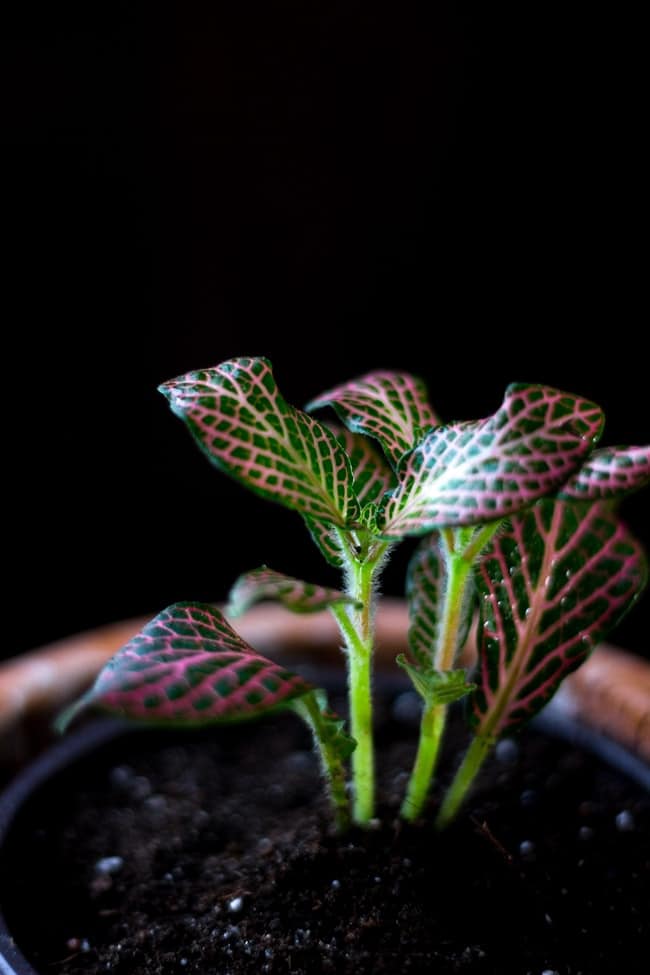
To recreate the native soils that the fittonia plant evolved to grow in, you need a potting mixture that is rich in organic matter and that holds water well while at the same time providing good drainage. A peat-based potting mixture, such as African violet potting mix, or a loamy indoor potting soil are good options, since they offer both organic matter and moisture retention. To ensure that it doesn’t become waterlogged, be sure to include a little coarse sand in your nerve plant potting mixture of choice.
Always be sure the container your fittonia nerve plant is in has a drainage hole, and never allow it to sit directly in standing water.
Fittonia plants should be repotted every year or two in the spring to refresh their soil. Since they have shallow roots, they can be kept in small pots and other tight growing conditions.
Best Strawberry Varieties
There are many varieties of strawberries. In fact, there are too many to mention here. However, I’m going to share the most popular types to give you a good starting point.
Keep in mind strawberries have different growing options. You can grow a June-bearing plant, which will produce in June as the name suggests because they need the long summer days.
There is an ever-bearing variety which will give you 2 crops, 1 early and 1 late. They don’t require such vast amounts of sunlight.
Finally, there is a day-neutral variety that will produce a crop from summer through fall instead of just 1 or 2 crops for the season like the other varieties.
1. Allstar
The ‘All-Star’ is a June-bearing variety. It produces a shiny, gorgeous strawberry in the perfect ‘strawberry shape.’
This variety is an excellent option if you’re looking to have fresh strawberries or if you’d like to freeze your harvest for later use.
2. Seascape
‘Seascape’ is an ever-bearing variety. It produces large fruit and is a great option if you live in a hot or dry location because of its ability to handle both heat and drought unusually well.
3. Ozark Beauty
‘Ozark Beauty’ is one of the most popular ever-bearing varieties. It produces an early crop and provides a second crop later in the season.
That sets this variety apart because most strawberry types usually only produce 1 crop, but you get a 2 for 1 when planting this type of strawberry.
4. Chandler
‘Chandler’ is a favorite June-bearing variety of strawberry. People love it because it produces a more abundant harvest.
Also, this variety is excellent for eating fresh, shipping (if you have a strawberry business), and they’re great for freezing.
5. Tristar
‘Tristar’ is a favorite day-neutral variety that will produce a constant harvest of medium-sized fruit from summer to fall.
Because the plants produce runners, it makes them ideal for hanging baskets.
6. Sparkle
When you think of strawberries, you probably think of this variety. It has been a popular choice for over 60 years because it produces medium-sized fruit later in the season that is great for making jam.
It’s another variety suitable for hanging baskets because of the runners it produces.
7. Jewel
This variety of strawberry has a sweet flavor but a tougher skin than other varieties. This makes it an ideal choice if you are in the strawberry business.
If you ship strawberries or own a pick-your-own, you might like these strawberries because the skin is less likely to bruise. Beyond their toughness, they are also popular because they produce longer than most other varieties.
8. Honeoye
‘Honeoye’ is June-bearing and a heavy producer. It creates larger and brighter berries that many people prefer.
Also, the berries that remain a consistent size throughout the time of production.
9. Earliglow
‘Earliglow’ is a popular June-bearing variety. They are the standard for other strawberries because they produce the earliest. It is common for other varieties to base their production time around this variety.
Plus, this variety is resistant to many common strawberry diseases and produces sweet but tough strawberries too. It’s a good variety if you want to can strawberries.
10. Surecrop
These June-bearing strawberries produce medium to large strawberries, which often have different shapes and sizes during production.
However, don’t let the inconsistency in shapes and sizes deter you because this crop will produce in any location, even those with poor soil.
11. Fort Laramie
Our final favorite strawberry variety is an ever-bearing variety that produces large fruit. These strawberries are great for enjoying fresh or for canning.
This variety is also great if you are trying to grow strawberries in a hydroponic system.
Planting Strawberry growing tips
- Can be planted from the schools acquired commercially at nurseries, which are nothing more than the children obtained from mother plants or to through seeds, although it is a more complicated and time- consuming option, it is also possible
- It is recommended to acquire the seedlings that have a healthy appearance and make sure that they do not have the presence of any plague, likewise to acquire them a day before sowing, in such a way as to leave the plant soaking in water overnight.
- Depending on the type of planting strawberry you want to grow, different fruits will be obtained, there are many pure species of strawberry and there are also the so-called hybrids.
- The holes to be dug should be about 8 cm deep and separated by at least 30 cm from each other.
- The distance may seem excessive at first, but as the plant begins to flower the entire area will be dense.
- Once the holes have been dug and the seedlings planted, it will be enough to cover the holes with the same soil, making sure that the roots are well covered and the ground is compact.
- It is recommended to water the land as indicated above and that’s it, just the aforementioned care and wait for flowering will suffice.
- A tip to keep the soil moist is to make a straw padded soil on the ground, which will also help prevent the proliferation of weeds.
- On the other hand, covers with wire tunnels, posts, and ridges are suitable to protect the plant from extreme freezing temperatures and help accelerate the ripening of the fruits.
Strawberry Varieties
Tobias Titz / Getty Images
Pick a strawberry variety that is adapted to your region and likely to thrive. For example, some will overwinter better than others or resist heat.
- Everbearing is a misleading name. This type generally produces fruit once in spring and then again in late summer.
- June-bearing strawberries such as Earliglow, Honeoye, and Jewel produce fruit over a short, four-week season. These are best for making jam or freezing in big batches. They also create many stolons and will fill your plot nicely. They do not fruit in the first year they are planted.
- Day-neutral plants like Albion and Seascape will produce all season, as long as the temperature is between 40 and 90 degrees F. They are particularly good for container gardening.
- Alpine strawberries are day-neutral, smaller like wild strawberries, and have a burst of flavor. They don’t mind a bit of shade.
What Is The Best Soil To Plant Coffee Plants?
There is always a debate as to what exactly is the best soil to grow a potted coffee plant in. It’s best to try and give plants what they naturally grow in.
Let’s begin with what we know coffee plants grow best with:
- Soil on the acidic side. A soil pH of 6.0 to 6.5 is ideal.
- Lots of compost
The coffee plant is an understory tree, growing in the shade of other trees or bananas, where new natural compost is always being added continuously.
When plants are small (under 8” inches) potting with an organic potting mix should work fine.
Once coffee plants reach a pot size of 10” or so using a more “specialty” soil mix will create a better environment for the root system to flourish.
Use a soil with a lot of organic matter, good drainage, and volcanic rock.
Below are two soil mixes recommended for planting coffee and promote vigorous growth..
Coffee Soil Mix #1
- 3 parts – Cactus soil mix
- 1 part – Volcanic rock dust
Coffee Soil Mix #2
- 1 part – Peat moss – (naturally acidic, good for pH, helps with water retention)
- 1 part – Compost – (provides nutrients and water retention)
- 1 part – Vermiculite (helps with soil structure and aeration)
- 1 part – Volcanic rock dust (provides iron, other micronutrients)
Tips On Potting Your Coffee Plant Tree
Your coffee plant should reach about 8″ inches in the 4″ inch pot before it is ready for repotting.
Once the plant reaches this size it is ready to spread its roots and grow. At this stage, the plant will require more nitrogen to support the trunk, leaves, and branches.
At this stage, the plant will require more nitrogen to support the trunk, leaves, and branches.
Repot in the spring into a 10” inch pot with one of the above soil mixes when the growing season starts.
In 12 to 18 months the plant should be approximately 24″-36″ and ready for stepping up into a 14″- inch pot (7 -gallon).
Strawberry Plant Info:
- Hardiness Zones: 2, 3, 4, 5, 6, 7, 8, 9, 10, 11
- Soil: Loamy, sandy PH between 5.5-7.0, deep, well-drained, rich in organic matter
- Sun Exposure: Full sun, 6-10 hours a day of direct sunlight
- Planting: Plant 2- 3 weeks before the average date in spring
- Spacing: 15-24-inches between plants and 36-48-inches between rows
- Depth: ¼-inch seed depth, make planting holes deep and wide to accommodate the seedling root system without bending
- Best Companions: Beans, chive, borage, peas, radish, spinach, onion, lettuce, marigold, sage, fennel, dill, coriander, caraway, asparagus
- Worst Companions: Cabbage, cauliflower, broccoli, brussels sprout, collard greens, kale, kohlrabi, okra, melon, rose, celery
- Watering: Water regularly and adequately, 1-1.5-inches per week
- Fertilizing: Apply balanced fertilizer one month after planting, you can fertilize in the spring and again in the fall
- Common Problems: Angular leaf spot, leaf scorch, anthracnose, gray mold, leaf spot, phomopsis leaf blight, powdery mildew, red stele, slugs, aphids, armyworm, Japanese beetle, loopers, thrips, weevils, spider mites
- Harvest: Harvest when the fruits are fully red, typically 4-6 weeks after blossoming
Pruning Abutilons…
Pruning Flowering Maples — Abutilons — Simply prune as and
when required. In particular, after the winter damage, when most types
can be cut back quite hard. This will encourage strong growth — which
will soon regain its original height.
Abutilon megapotamicum is best pruned less
severely, and simply to train along fence or wall — selecting the
strongest shoots to build a framework of flowering new shoots.
Other Abutilon Varieties
Abutilon Kentish Belle
Abutilon palmeri
Abutilon theophrasti
Abutilon Pictum
Abutilon hybridum
Abutilon Little Imp
Abutilon Red Tiger
Abutilon indicum
Abutilon striatum
Abutilon incanum
Abutilon fruiticosum
Information On Wandering Jews
Wandering jews (Tradescantia) are tropical plants that add wonderful color to mixed containers and shady garden areas.
They’re commonly sold as annual plants in cold climates. But they are actually tropical perennials in their native environment.
They are not tolerant of the cold, and will die at the first hard freeze if left outdoors. But they can easily be brought indoors and grown as a houseplant through the winter.
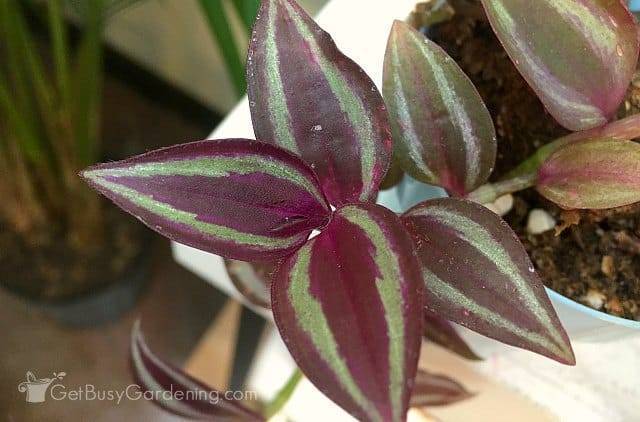
Purple variegated wandering jew (zebrina)
Different Wandering Jew Varieties
When you think of a wandering jew plant, you might think about the classic variety with purple and silver variegated leaves (Tradescantia zebrina, aka “inch plant”).
But the common name actually refers to a whole family of plants that fall under the scientific name of “Tradescantia”. Tradescantia wandering jew plants all require similar care, and they are all fairly easy to grow.
There are a whole bunch of different types, and they are all equally beautiful. There are plain green ones, variegated, purple, and even fuzzy leaf ones.
Whew, with all those options, how will you ever decide which variety to grow (I guess you could just start a collection like me!).
Related Post: 17 Beautiful Purple Houseplants To Liven Up Your Home
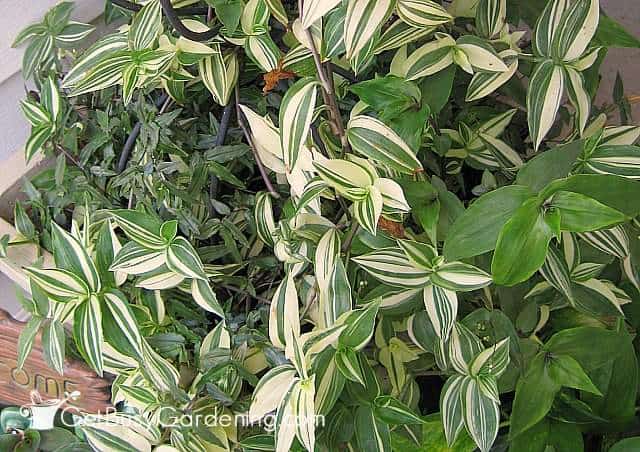
Mixed planter of different wandering jew varieties
Here’s a list of the most common wandering jew varieties (take a look at the pictures throughout this post to see what some of them look like).
- Bolivian (while this is called “wandering jew”, it’s actually a different species)
- Bridal veil
- Red burgundy
- Purple fuzzy leaves
- Green fuzzy leaves
- Tricolor
- White/green variegated
- Purple queen (aka: purple heart)
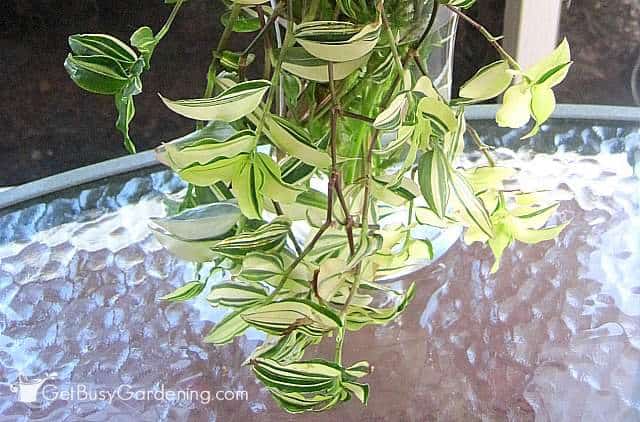
Green and white variegated wandering jew
Harvesting and Enjoying Your Crop
Once your berries begin to ripen, watch them closely and pick strawberries as soon as they’re fully colored and ripe. Harvest early in the morning when berries are cool to help reduce bruising. Leave a short stem attached to the green cap to extend their freshness as well.
Strawberries don’t last long once they’re picked, so refrigerate them – or eat them – right away. Too help them last longer, don’t wash your strawberries until you’re ready to use them. A typical strawberry plant produces about 1 to 2 pounds of berries per season,1 so plan your menus and your planting accordingly.
With homegrown strawberries from your garden, you’ll enjoy the smiles of family and friends as they bite into garden-fresh berries grown with your hands. Pennington is committed to providing you with the finest lawn and garden products and timely growing tips to help you learn, grow and meet your gardening goals – including your own homegrown strawberry harvest.
Penningtonwith design is a registered trademark of Pennington Seed, Inc.
Sources:
STRAWBERRY VARIETIES
Swipe to view slides
Photo by: Proven Winners.
Berried Treasure Red — Buy plants and seeds from Proven WinnersFragaria ×ananassa
Type: EverbearingZones: 4-9 Height/Spread: 12 to 16 inches tall and 18 to 24 inches wideBloom & fruit time: Late spring through fallColor: Red flowers, red berries
Attractive, semi-double red flowers. Grow in an ornamental edible plot, container, raised bed, or as edging. Runners can be trimmed back or allowed to sprawl.
Also: Berried Treasure Pink, Berried Treasure White
Photo by: ButtermilkgirlVirginia / Shutterstock
‘Allstar’Fragaria ×ananassa
Type: June bearingZones: 4-8Height/Spread: 8 to 10 inches tall and 12 to 18 inches wideBloom & fruit time: Late spring, mid-seasonColor: White flowers, red berries
Frost and heat resistant, grows well in most areas. Large, juicy fruit has a sweet, mild flavor. Excellent resistance to fungal diseases.
Photo courtesy Burpee
‘Earliglow’
Type: June bearingZones: 4-8 Height/Spread: 8 to 10 inches tall and 8 to 12 inches wideBloom & fruit time: Late springColor: White flowers, red berries
Produces vigorous plants with lots of runners. The large firm berries have excellent sweet flavor. Disease-resistant and cold-tolerant plants.
Photo by: Brendan Delaney / Shutterstock
‘Honeoye’Fragaria ×ananassa
Type: June bearingZones: 3-8Height/Spread: 8 to 10 inches tall and 8 to 18 inches wideBloom Time: Late springColor: White flowers, red berries
Exceptional winter hardiness, growing well in the northeast and upper midwest. Plants are vigorous and disease-resistant, producing high yields of large, firm, sweet-tasting berries. One of the best varieties for freezing.
Photo by: Kassia Marie Ott / Shutterstock
‘Alexandria’Fragaria vesca
Type: AlpineZones: 5-8Height/Spread: 8-10 inches tall and 14-18 inches wideBloom & fruit time: Late spring through fallColor: White flowers, red berries
Produces an abundant crop of thumbnail-sized fruit with exceptional flavor. Plants produce in their first year, with harvest lasting into fall during the following year. Compact runner-less growth makes it a good choice for containers, raised beds, window boxes, or indoor gardening.
Photo courtesy Burpee
‘Tristan’
Type: EverbearingZones: 4-8Height/Spread: 8 to 12 inches tall and 14 to 24 inches wideBloom Time: Late spring through fallColor: Rose-pink flowers, red berries
A unique combination of deep red berries and rose-pink flowers makes this everbearing variety as attractive as the berries are tasty. The compact runner-less plants look great in containers or small kitchen plots, producing an abundant harvest of elongated sweet fruits throughout the summer.
Photo by: Anya Douglas / Shutterstock
‘Eversweet’Fragaria ×ananassa
Type: Day-neutralZones: 4-9Height/Spread: 8 to 16 inches tall and 12 to 18 inches wideBloom Time: Late spring through fallColor: White flowers, red berries
Produces berries in heat up to 100 degrees F, with a big crop in early summer and smaller crops into fall. Large, sweet fruit can be eaten fresh or frozen.
Photo by: luis abrantes / Shutterstock
‘Pineberry’Fragaria x ananassa
Type: EverbearingZones: 5-8Height/Spread: 8 to 12 inches tall and 10 to 18 inches wideBloom Time: Late spring through fallColor: White flowers, white berries with red seeds
Produces white fruits that smell and taste like pineapple, perfect for gourmet cooking, salads, or snacking. Not to be confused with white alpine strawberry, which looks similar.
Top 10 Tips for Growing Strawberries — Palmers Garden Centre
www.palmers.co.nz
Plant your strawberries early for a bumper harvest! We know that June seems really early to be thinking about planting strawberries, but the earlier you get them in the more fruit you will get and who doesn’t want more strawberries?!
Plant in a sunny area. You will get the best flavour from strawberries that are planted in a sunny spot. We do however recommend when planting to get them into the soil early in the morning or late in the day so plants aren’t exposed to hot sun straight away.
Give them some space! Strawberries like to have room to breathe so give them at least 30cm of depth in the soil and at least 40cm between each row of plants.
Don’t drown the strawberries. Strawberries don’t like to be waterlogged. They will rot easily in these conditions so ensure your soil drains well. Planting strawberries in small mounds will help prevent the soil from becoming too damp.
Seen 124 times
Growing strawberries from seed:
CROP CARE
Twenty days after planting strawberry, a carpid is made. Irrigation can be localized, with a perforated polyethylene sleeve, drip irrigation, or furrow. In summer we water 2 times a day and in winter 2 to 3 times a week. Regarding diseases, it is a crop that requires a lot of care, on the one hand, we have those caused by fungi such as Powdery mildew (whitish spots on the underside of leaves), these deform and curl and can affect the entire plant, smallpox (affects only the aerial part with dark spots), burn or scald (on the petiole, stems and leaves, purple to yellow spots).
Of the diseases caused by bacteria, the most important is the angular spot on the leaf (small spots delimited by the veins, watery on the underside of the leaves, transparent to the light, can cover the entire leaf).
Diseases caused by viruses cause loss of vigor, light green mottling on leaves, chlorotic spots or bands along the veins, dwarfism, leaf deformation. Most are transmitted by vectors such as aphids and thrips).
Harvest Of Planting Strawberry
The fruit, which we also know as “strawberry” is actually a thickening of the flower receptacle, the “dots” on it being the real fruits.
The fruit must be almost completely red and with its characteristic aroma to take advantage of its beneficial components (antioxidants, vitamin C, fiber, and potassium), harvesting it carefully in the morning, preserving the upper leaves and a small piece of the peduncle
